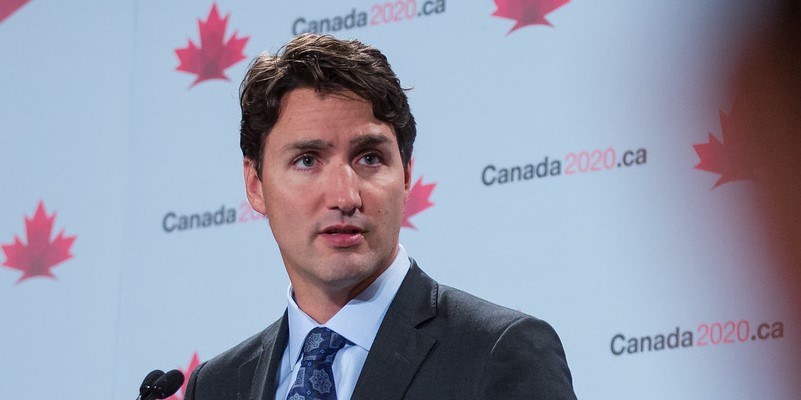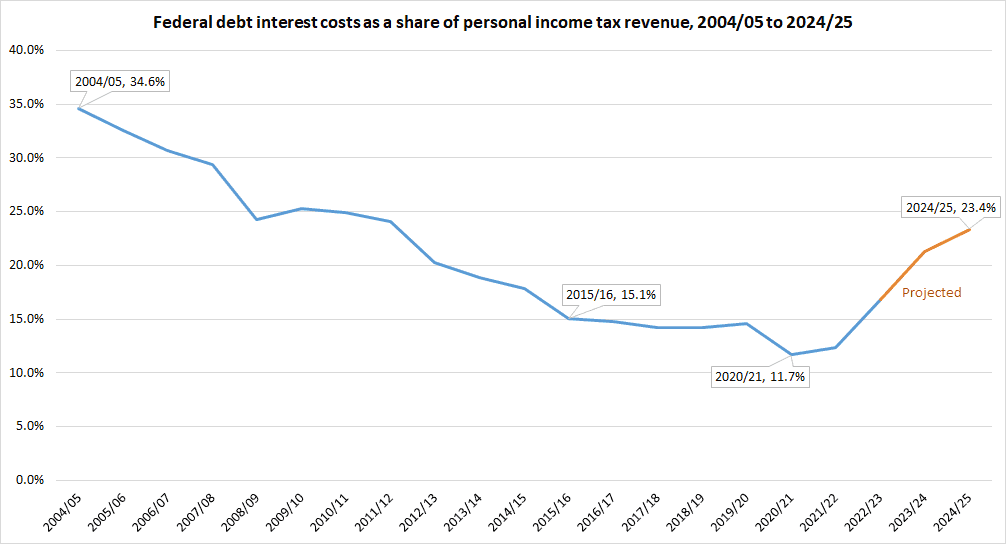Federal debt interest will consume nearly one quarter of income tax revenue in 2024

The Trudeau government will table its next budget on April 16. In recent years, the government has overseen a substantial rise in the amount of interest it must pay to service federal debt, reversing a long-standing trend of interest costs declining relative to personal income tax revenues. By 2024/25, according to projections, nearly one in four dollars of personal income tax revenue will go towards debt interest.
Just like how individuals must pay interest when they take out a mortgage, the government must also pay interest when it borrows money. These interest payments represent taxpayer dollars that don’t go towards programs or services for Canadians.
When interest costs rise faster than the government’s ability to pay—i.e. the revenues it brings in—the government will face pressure to take on more debt to maintain funding for programs and services. And by taking on more debt, this places additional upward pressure on interest costs (all else equal) and the cycle repeats.
A useful way to track this is to measure debt interest costs as a share of federal personal income tax (PIT) revenues, which represent Ottawa’s single-most important revenue source. In 2024/25, they’re expected to comprise just under half (46.4 per cent) of total revenues and therefore provide a useful gauge of the government’s ability to pay interest on its debt. As such, the chart below includes projections for federal debt interest costs as a share of PIT revenues for the two decades from 2004/05 to 2024/25.
As we can see from the chart, for many years federal debt interest costs had been declining as a share of PIT revenues. In 2004/05, 34.6 per cent of PIT revenues went towards servicing federal debt, but by 2015/16 that share had fallen to 15.1 per cent. In other words, during the Trudeau government’s first year in office, federal interest costs consumed less than one in six dollars of personal income tax revenue paid by Canadians. Interest costs as a share of PIT revenues continued to fall for the next several years, down to a low of 11.7 per cent in 2020/21. However, this marked the end of the decline, and the years since have seen rapid growth in debt interest costs that far exceeds growth in PIT revenues.
In the two years from 2020/21 to 2022/23, federal interest payments rose from 11.7 per cent of PIT revenues to 16.8 per cent. And by the end of the upcoming fiscal year in 2024/25, debt interest payments will reach a projected 23.4 per cent of PIT revenues. In four years, debt interest payments are expected to have gone from consuming about one in nine dollars of PIT revenue to nearly one in four dollars. Put differently, nearly one quarter of the money taxpayers send to Ottawa in the form of personal income taxes will not go towards any programs or services in 2024/25.
The causes of this sudden rise in interest costs as a share of PIT revenues are the combined effects of a substantial accumulation of debt under the Trudeau government, and a recent rise in interest rates. From 2015/16 to 2022/23, the Trudeau government added $820.7 billion in gross federal debt, and by 2024/25 total debt will reach a projected $2.1 trillion—roughly double the amount inherited by the current government. Meanwhile, from 2022 to 2023, the Bank of Canada increased its policy interest rate from a low of 0.25 per cent to the current rate of 5.00 per cent.
Simply put, federal debt interest costs have risen and are expected to eat up almost one quarter of federal PIT revenues by 2024/25. To help prevent taxpayers from devoting an even larger share of their tax dollars towards debt interest, the Trudeau government should cease its heavy reliance on borrowing in this year’s federal budget.
Authors:
Subscribe to the Fraser Institute
Get the latest news from the Fraser Institute on the latest research studies, news and events.


